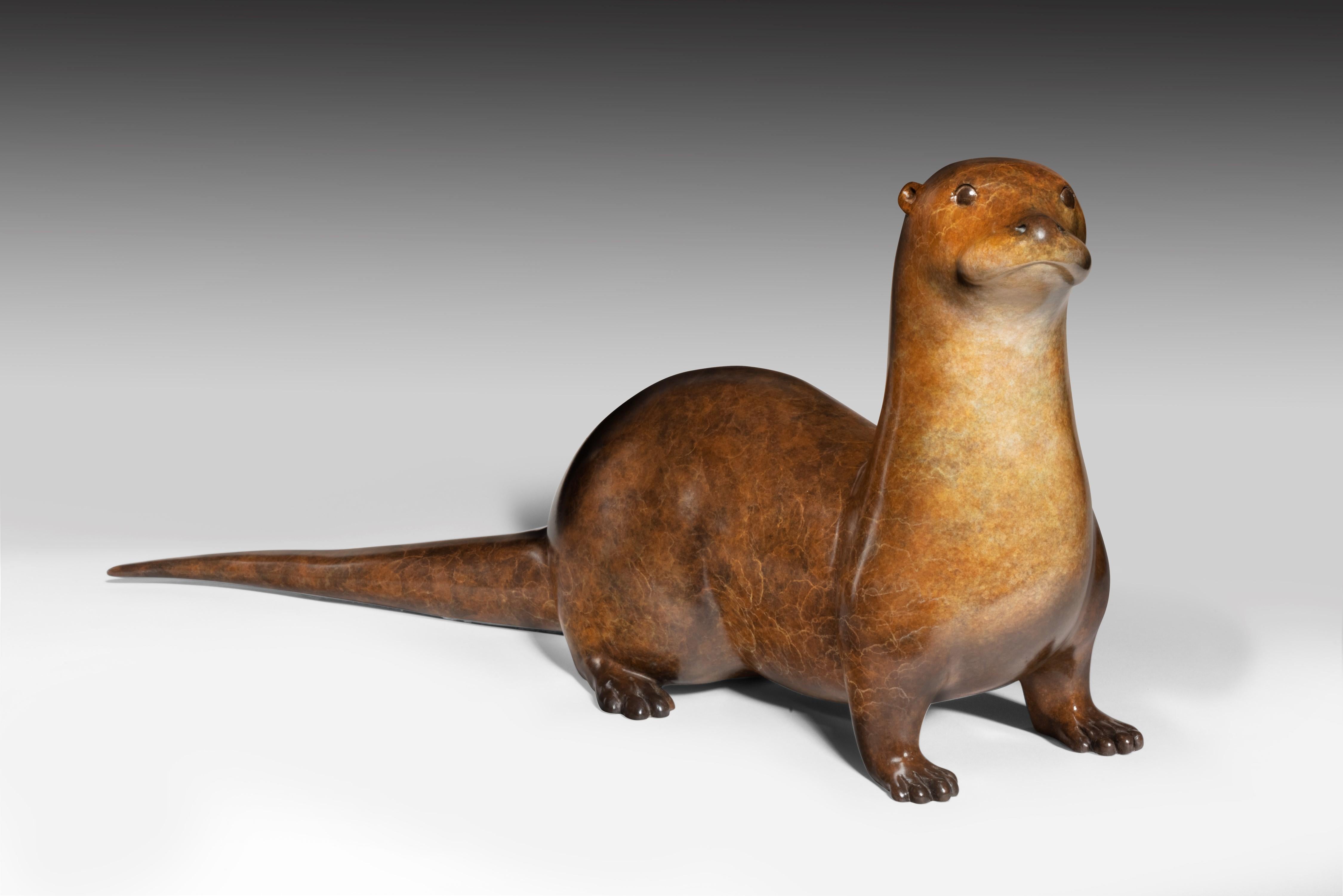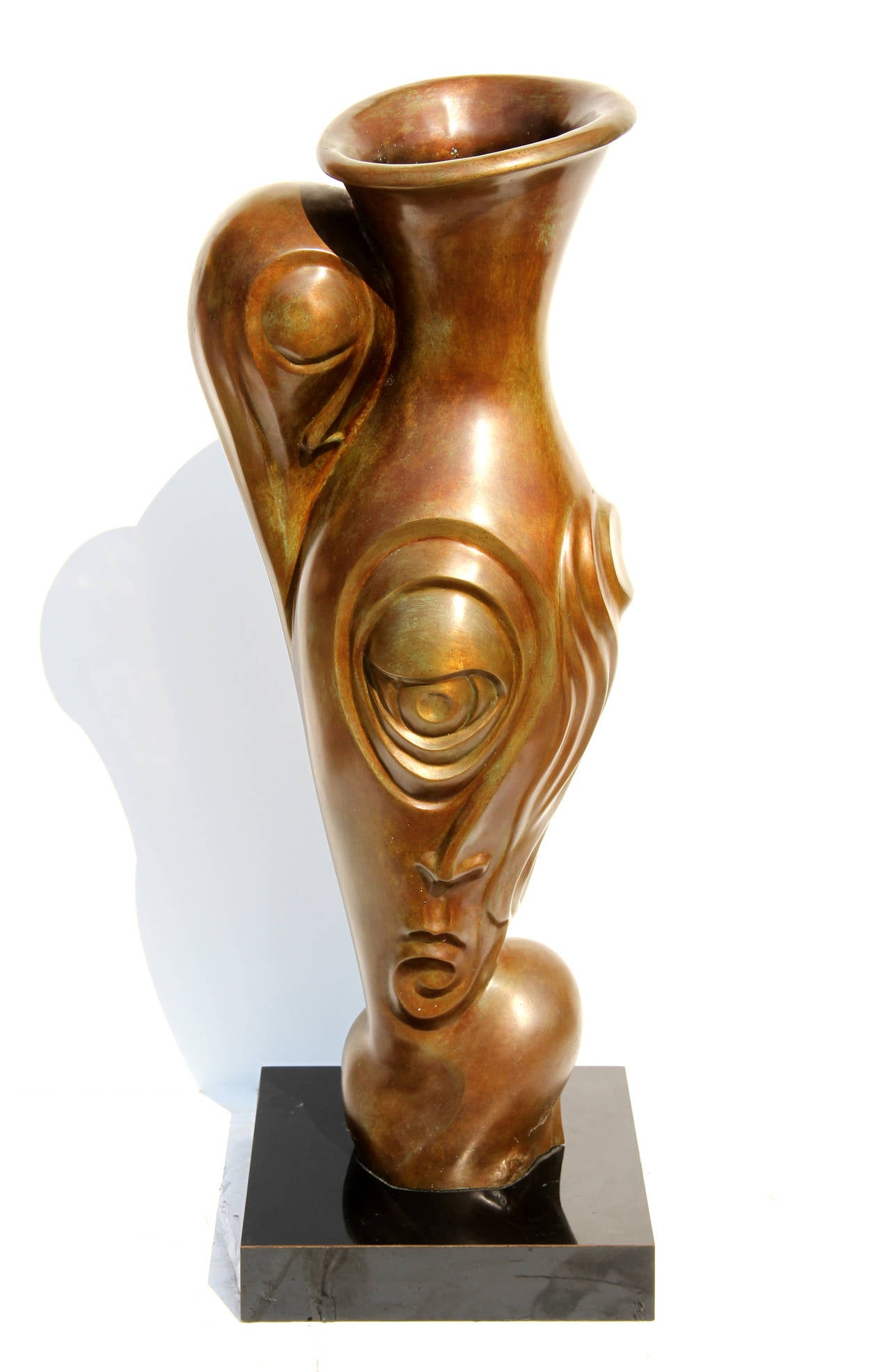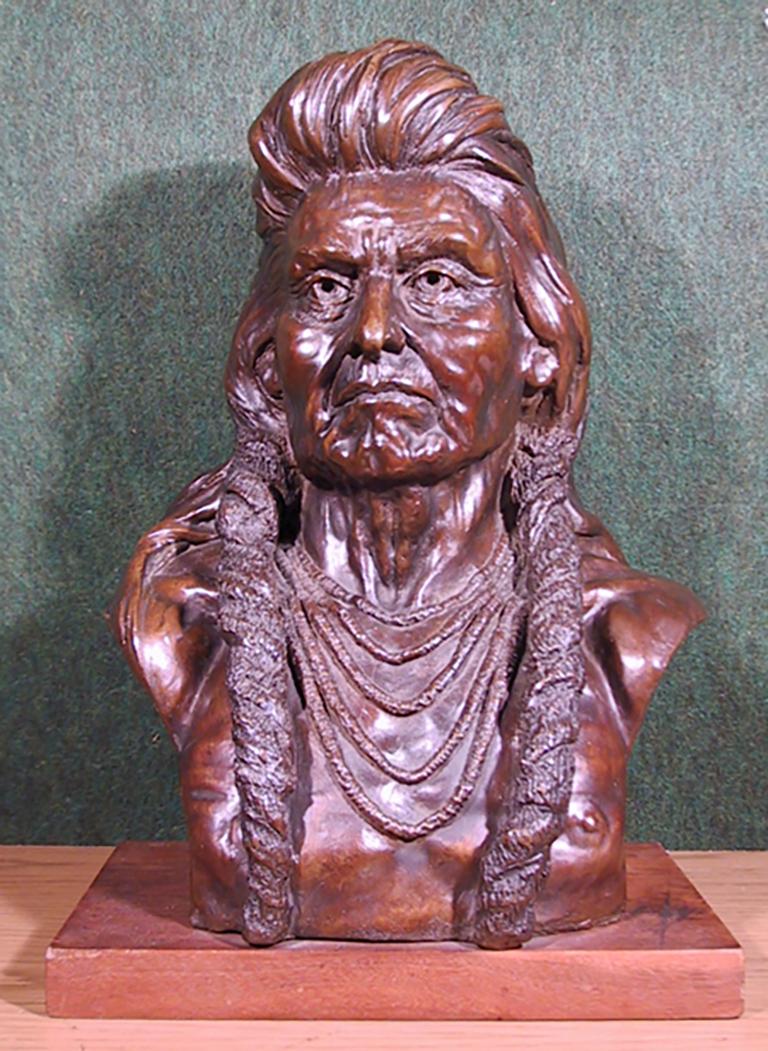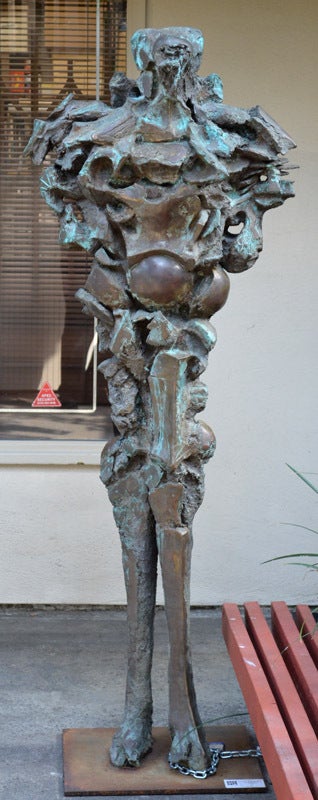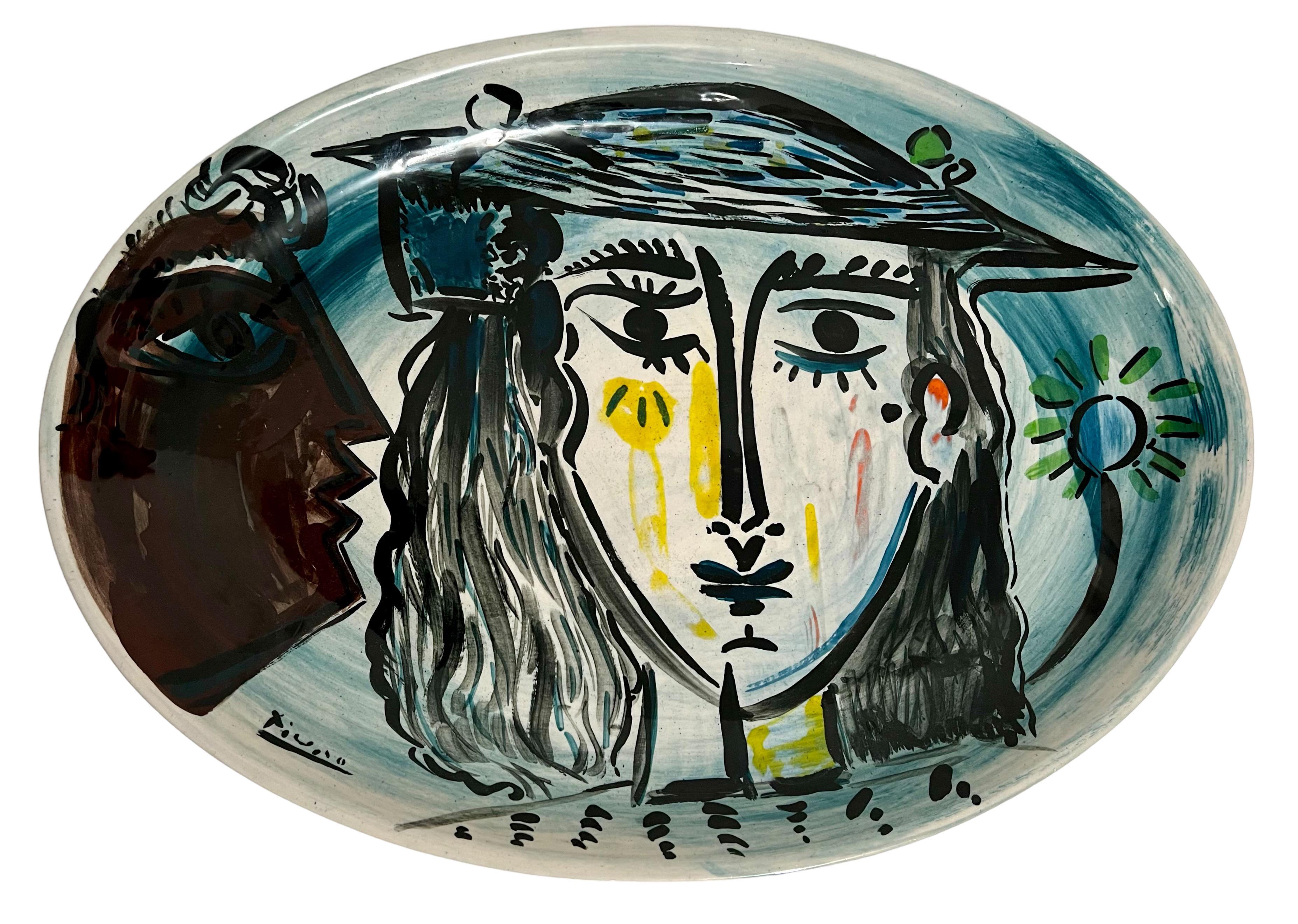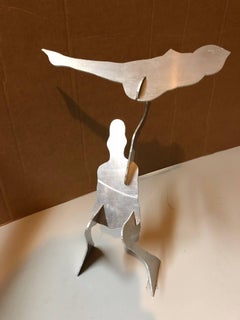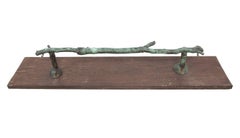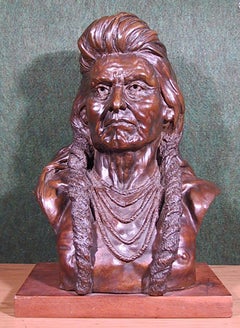Items Similar to Jerusalem Rabbi, Repousse Sculpture Relief Plaque Israeli Judaica
Want more images or videos?
Request additional images or videos from the seller
1 of 5
Arieh MerzerJerusalem Rabbi, Repousse Sculpture Relief Plaque Israeli Judaica
About the Item
Arieh Merzer was a prominent Israeli artist and metal worker.
Arie Merzer, an artist who worked in hand-hammered copper, was born in Warsaw, Poland in 1905, the scion of a large Hassidic family. He graduated from the Academy of Arts in Warsaw, and became the pupil of Professor Adam Richtarsky. He later worked with a group of Jewish artists who wanted to resuscitate the ancient oriental-Jewish craft of hand-hammering metal (metaloplastics), which was passed on to us as a legacy by far-off generations from the time of the Bible.
In 1928 Arieh Merzer exhibited his works in Warsaw for the first time. From 1930 he lived and worked in Paris. He was one of the Jewish artists who gathered there and were known as the Jewish 'Ecole de Paris.' Merzer regularly exhibited in the well-known 'Salon d'Automne' and 'Salon des Tuileries,' as well as in solo exhibitions in Paris and throughout France.
Arieh Merzer's work was highly acclaimed well before the Holocaust, before it became a memorial to a world destroyed. He portrayed the story of the Jewish spirit on copper, on silver, and on gold: stories from the Bible, the life-styles of the Jews in their shtetls and ghettos, of Chassidim and Kabbalists of renown, of wars of liberation and revival.
A special stress was placed on the link between the new Jewish experience and its historical nucleus. His major innovation was the moulding of mystic and traditional Jewish motifs, that surrounded the Holy Ark in Europe's burning synagogues, and presenting the results before the world of modern art. As a result he became generally recognized as an international Jewish artist.
In 1943, when France was conquered by the Nazis, Arieh Merzer escaped from a concentration camp, and after a stint in the maquis, he crossed the border into Switzerland and was sent to a labor camp. Later, he arrived in Geneva, where an album of sketches of his works was put out. In 1945 he made aliyah to Israel with his family, settled in Safed, and helped to found the Artists' Quarter there.
Arieh Merzer lived and worked in Israel for twenty-one years. His exhibitions in the country include: 1946 in the Tel Aviv Museum; 1947 in the Pevsner Artists' Pavilion in Haifa; 1951 in the Artists' Pavilion in Tel Aviv; 1955 in the Museum for Modern Art in Haifa; 1955 in the Artists' Pavilion in Jerusalem; and 1957 in the Tel Aviv Museum. His works were also on permanent show in his atelier in Safed. He was awarded prizes, including: the Herman Struck prize in 1946; the Dizengoff prize in 1951 and then again in 1965; and the Mayor of Haifa's prize in 1954. His works appear in numerous museums and collections throughout the country and abroad. His heart stopped beating on the eve of Holocaust Day, 1966.
Arieh Merzer, who was brought up in a Hassidic family, was drawn to the world of art from an early age; he was influenced by the moods and new ideals of the socialist circles and prepared himself to study art in the academy. On Passover eve , after clearing out the bread, while the rest of the household was busy preparing for the Holiday, a book fell from the bookcase and from out its pages flew dozens of sketches and drawings of nudes that the young Arieh had prepared for his folio for the entrance examinations to the academy. His sisters tore up the drawings with cries of treyfe treyfe (ritually non-kosher) and many months' hard work went down the drain. As a result of this, he left his home at the age of fifteen, and later joined a group of young artists who wanted to revive the ancient art of hand-hammered copper - metaloplastics - bequeathed to them by past generations who lived in Bible times.
Thus did he part from his family - mother, father, thirteen brothers and sisters - who all perished in the Holocaust. He alone survived, and made an oath that he would commemorate in copper all who had died.
The pictures do not do justice to this magnificent item.
- Creator:Arieh Merzer (1905 - 1966, French)
- Dimensions:Height: 9.5 in (24.13 cm)Width: 7.5 in (19.05 cm)Depth: 1 in (2.54 cm)
- Medium:
- Movement & Style:
- Period:
- Condition:Original frame, has wear, see photos. Measurements include frame.
- Gallery Location:Surfside, FL
- Reference Number:1stDibs: LU38211574502
About the Seller
4.9
Platinum Seller
These expertly vetted sellers are 1stDibs' most experienced sellers and are rated highest by our customers.
Established in 1995
1stDibs seller since 2014
1,591 sales on 1stDibs
Typical response time: 1 hour
- ShippingRetrieving quote...Ships From: Surfside, FL
- Return PolicyA return for this item may be initiated within 3 days of delivery.
Authenticity Guarantee
In the unlikely event there’s an issue with an item’s authenticity, contact us within 1 year for a full refund. DetailsMoney-Back Guarantee
If your item is not as described, is damaged in transit, or does not arrive, contact us within 7 days for a full refund. Details24-Hour Cancellation
You have a 24-hour grace period in which to reconsider your purchase, with no questions asked.Vetted Professional Sellers
Our world-class sellers must adhere to strict standards for service and quality, maintaining the integrity of our listings.Price-Match Guarantee
If you find that a seller listed the same item for a lower price elsewhere, we’ll match it.Trusted Global Delivery
Our best-in-class carrier network provides specialized shipping options worldwide, including custom delivery.More From This Seller
View AllCeramic Plate by Master Art Forger David Stein after Pablo Picasso Vallauris
Located in Surfside, FL
Apres Pablo Picasso (bears a pseudo signature recto)
Hand signed David Stein, dated 1979 verso.
Figural painted porcelain or ceramic serving dish, oval form.
Dimensions: 18" X 14
David Stein (born Henri Haddad, 1935, Alexandria, Egypt – died 1999, Bordeaux, France) was an artist (notorious art forger) who, until 1966, had been frequently sentenced for theft by the French courts before becoming an art forger and art dealer with 15 aliases.
Stein often copied paintings in the style of the masters. For example, he studied Marc Chagall, Matisse, Braque, Paul Klee, Joan Miró, Pablo Picasso, Jean Cocteau and Rouault, in order to copy their color scheme and inspirations.
In 1967 Marc Chagall notified authorities of forgeries of his work hanging in a New York gallery, and Stein was arrested. Art dealers refused to cooperate with the prosecution because it would have incriminated them and made their expertise in the art field questionable. Some art collectors refused to give up their paintings as evidence. Stein was convicted of six counts of art forgery and grand larceny. During his prison term, Joseph Stone, the judge who arrested him, brought him to his office to paint. He remained a good friend of the Stein family long after Stein completed his jail sentence. In 1989 he discovered that Stein never stopped making forgeries.
After Stein had served his prison term in the United States, he was deported to France where he served another term. Prison authorities allowed him to make further paintings, although now using his own name. In 1969 a London gallery sold some of these paintings. After Stein was released, he returned to painting, this time selling his paintings under his own name to put a mask on his real activities.
The book Three Picasso's Before Breakfast (Mémoirs of an Art Forger's Wife) by Anne Marie Stein as told to Georges Carpozi Jr (Hawthorn Book Inc) was written by David's life partner Anne-Marie about their experiences in the art world. In the mid 1980s director Gil Cates gave his agent Arthur Axelman at William Morris a copy of the book which had been written without Stein's involvement. Axelman set out to find Stein and after several years he located him in Manhattan. Stein became an Axelman client and friend. While deals at HBO and ABC did not lead to production of a film, Axelman introduced Stein to Keith Carradine and Alan Rudolph, director of the movie "The Moderns" with ultimately starred John Lone, Géraldine Chaplin, Keith Carradine and Linda Fiorentino. The film was set in the Paris of the '20s although filmed in Montreal. Stein appeared in the film as an art critic and provided all of the art. A minor concern was a scene where a painting in the style of Matisse and Modigliani was to be burned on camera and a Modigliani destroyed by knife. No one cared to destroy any of Stein's copies, "Just good for the camera" say Stein. but a William Morris assistant for agent Axelman suggested making large format copies of the works to be destroyed. Stein refused and during the scene actor John Lone destroyed the Paintings.
Stein was living in France after his troubles with the US immigration who had told him to leave US territory in 1988. He met the French photo...
Category
1970s Modern Figurative Sculptures
Materials
Enamel
The Test, Assembled Kinetic Modernist Sculpture Puzzle Construction
By William King (b.1925)
Located in Surfside, FL
"The Test," 1970
Aluminum sculpture in 5 parts.
Artist's cipher and AP stamped into male figure, front,
20 5/16" x 12 1/2" x 6 5/7" (approx.)
American sculptor King is most noted for his long-limbed figurative public art sculptures depicting people engaged in everyday activities such as reading or conversing. He created his busts and figures in a variety of materials, including clay, wood, metal, and textiles. William Dickey King was born in Jacksonville, Florida. As a boy, William made model airplanes and helped his father and older brother build furniture and boats.
He came to New York, where he attended the Cooper Union and began selling his early sculptures even before he graduated. He later studied with the sculptor Milton Hebald and traveled to Italy on a Fulbright grant.
Mr. King worked in clay, wood, bronze, vinyl, burlap and aluminum. He worked both big and small, from busts and toylike figures to large public art pieces depicting familiar human poses — a seated, cross-legged man reading; a Western couple (he in a cowboy hat, she in a long dress) holding hands; a tall man reaching down to tug along a recalcitrant little boy; a crowd of robotic-looking men walking in lock step. Mr. King’s work often reflected the times, taking on fashions and occasional politics. In the 1960s and 1970s, his work featuring African-American figures (including the activist Angela Davis, with hands cuffed behind her back) evoked his interest in civil rights.
But for all its variation, what unified his work was a wry observer’s arched eyebrow, the pointed humor and witty rue of a fatalist. His figurative sculptures, often with long, spidery legs and an outlandishly skewed ratio of torso to appendages, use gestures and posture to suggest attitude and illustrate his own amusement with the unwieldiness of human physical equipment.
His subjects included tennis players and gymnasts, dancers and musicians, and he managed to show appreciation of their physical gifts and comic delight at their contortions and costumery. His suit-wearing businessmen often appeared haughty or pompous; his other men could seem timid or perplexed or awkward. Oddly, or perhaps tellingly, he tended to depict women more reverentially, though in his portrayals of couples the fragility and tender comedy inherent in couplehood settled equally on both partners.
His first solo exhibit took place in 1954 at the Alan Gallery in New York City. King was elected to the American Academy of Arts and Letters in 2003, and in 2007 the International Sculpture Center honored him with the Lifetime Achievement in Contemporary Sculpture Award. Mr. King’s work is in the collections of the Metropolitan Museum of Art, Guggenheim Museum, Whitney Museum and the Museum of Modern Art in New York and the Hirshorn Museum at the Smithsonian American Art Museum in Washington, among other places, and he had dozens of solo gallery shows in New York and elsewhere.
Reviews of his exhibitions frequently began with the caveat that even though the work was funny, it was also serious, displaying superior technical skills, imaginative vision and the bolstering weight of a range of influences, from the ancient Etruscans to American folk art to 20th-century artists including Giacometti, Calder and Elie Nadelman.
The New York Times critic Holland Cotter once described Mr. King’s sculpture as “comical-tragical-maniacal,” and “like Giacomettis conceived by John Cheever.”
Category
1970s American Modern Figurative Sculptures
Materials
Metal
Polish Modernist Stretching CAT Bronze Expressionist Art Sculpture
By Dominik Albinski
Located in Surfside, FL
Signed bronze from small edition of 8. plus 4 artists proofs
Dominik Albiński
(born 1975, South Africa)
Dominic Albinski, was born in South Africa, in 1975. He started sculpting, at
a young age, at the Art Classes of Mercia Desmond, in Johannesburg. From the
start, his talent for capturing movement, and character in his human, and animal
figures was remarkable. Dominic had a happy childhood, spending his time in the
studio, where he studied art and anatomy, which was later to become one of the
major themes of his sculptures. He also spent a lot of time on the South African
coast; Durban, North Coast and Cape, Plettenburg Bay and in the bush Kruger
Park, Okovango Swamps, Chobe and Pilansberg game reserves. He was a good
student, but preferred sculpting in his studio, among his artworks, than studying.
After finishing High School (St John’s College), he left for Paris, to start a life
of independence, in the French capital, famous for artists like Rodin, Bugatti,
Carpeaux, Daumier, Giacometti, and Picasso, who inspired him. He was excepted
into the prestigious Institute of Political Science. However, his passion for
sculpture, made him choose sculpture as a career.
He started studying sculpture at the Academy of Fine Arts in Warsaw, and
with the British Sculptor, James Butler in England. Here, he learnt observation and
techniques that would stand him in good stead later, when he came back to
France, as a Professor of Communication at the renowned Ecole Francaise
D’Attache de Presse near the Champs Elysees. He had his first major exhibition at
the Arnaud Gallery in Verneuil sur Avre in Normandy. A collector, found interest
in his work, and created a vast collection of his bronzes, as well as promoting
Dominic in various galleries in the region of Normandy, and Touraine, such as
Galerie 21 and Club de Arche de Noe, in Tours and Galerie des Remparts, and
Eclat de Verre, in Le Mans. He also exhibited in La Rochelle in the Galerie Hourdin,
and Bordeaux at the Galerie des Remparts. During this period he studied
Literature at the Sorbonne.
In Paris, several galleries took Dominic’s work, including Galerie Arcima, on
Rue St Jaques, Galerie Herouet, in the Marais, Galerie Etienne de Causans on rue
de Seine, or Galerie Mouvances, on Place des Vosges. Dominic participated in a
wildlife exhibition in Trocadero Center, and at the Hotel de Ville of Puteux. His
sculpture Madness, was chosen to be exhibited as a finalist at the Brain-Up
competition, in the Palais de Congres. This impressive sculpture, measuring 1m 60
is in the collection of the Hospital in Lille, and the Mandela Collection in Sandton
South Africa, among other collections.
In Poland, he had an exhibition in the Canadian Embassy Residence, in the
South African Embassy, and in the French Embassy. His work “Man with Pipe” is in
the collection of the Canadian Ambassador. His work “Portrait of Agnes” was
acquired by the South African Ambassador who, opened Dominic’s exhibition in
the Jagellonian University in Krakow, Holiday Inn, and in Galeria Mokotow, in
Warsaw. He had an exhibiton in the Warsaw Financial Center on Emili Platter
Street, and in the Sculpture Gallery on Jana Pawla street. Later, he exhibited in
the Gallery of the Polish War Museum on Krakowskie Przedmiescie, on Nowy
Swiat 44, in the Center of Promotion of Culture, Mazowieckie Center of Culture
and in the Jan Nowak Jezorianski Center. His work was showcased in the
Napiorkowska Gallery, Zapiecek Gallery on the square of the Old Town in Warsaw,
Hunters Gallery, and Warsaw Art Gallery in the Marriot Hotel, and sold on various
Auctions, such as Rempex, Agra Art, and Polswiss.
Back in South Africa, Dominic had much success among his native art
galleries, having his first major exhibition at the Mandela Square Gallery, in
Sandton. Art Galleries, hearing of his exhibitions in France, took his work, such as
the Cherie de Villiers Gallery, in the Mall, in Rosebank, and the Van den Berg
Gallery, in Potchefstroom. Dominic also took his work to the USA, where he
exhibited at the Modern Show in New York, and at the Dauphin Descours Gallery
on Madison Avenue, and the Yew Tree House Antiques Gallery in New York, as
well as the Geary Gallery, in Darion, and the Lions Gallery...
Category
Early 2000s Modern Figurative Sculptures
Materials
Bronze
Bronze Wall Hanging Sculpture, Verdigris Patina
By Ilana Goor
Located in Surfside, FL
Ilana Goor is an individualistic, autodidactic, intuitive and multifaceted artist. As an artist who knows no boundaries and whose art transcends any conventions, her creations are a blend of vitality and obsession, functional simplicity alongside expressive complexity bordering on surrealism. Her sources of inspiration are neither time nor place-dependent. They create a personal statement, a journey replete with meaning and they succeed in touching and moving people the world over.
Goor was born in Tiberias to an educated and distinguished family of highly respected doctors and artists. She never studied art or design in any formal setting. She developed her artistic techniques on her own from an early age, when she used various parts to create small statues. She is considered to be an international multidisciplinary artist. Her works encompass sculptures, furniture, judaica, lighting fixtures, jewelry and fashion items which are displayed in well known galleries worldwide and are distinguished by their powerful, dominant presence.
She first came to the United States in her 20s and captured the hearts of the locals with her large-buckle belts for men which paved her artistic path in North America. Since then Ilana Goor was requested to install statues in major public locations and exhibited her works in museums throughout Europe, America, Japan and Israel. Ilana Goor designed jewelry, buckles and sold belts to most major department stores in America including I Magnin, Neiman Marcus, Bloomingdale's, Macy's, Saks Fifth Ave. and in Japan.
In 1986 Ilana Goor introduced a collection of iron furniture and accessories to the American marketplace as limited editions signed by the artist.
She was awarded the Roscoe award for Best Design in residential seating in 1988.
Her works are presently displayed in sixteen decorator and designer showrooms throughout the United States. Her iron furniture collection was displayed in the Israel Museum, Jerusalem in1987 and in 1993 Ilana Goor introduced her collection of furniture in Japan...
Category
20th Century Modern Figurative Sculptures
Materials
Bronze
Polish Modernist Charging Rhino Bronze Expressionist Rhinoceros Sculpture
By Dominik Albinski
Located in Surfside, FL
Signed bronze from small edition of 8. plus 4 artists proofs
Dominik Albiński
(born 1975, South Africa)
Dominic Albinski, was born in South Africa, in 1975. He started sculpting, at
a young age, at the Art Classes of Mercia Desmond, in Johannesburg. From the
start, his talent for capturing movement, and character in his human, and animal
figures was remarkable. Dominic had a happy childhood, spending his time in the
studio, where he studied art and anatomy, which was later to become one of the
major themes of his sculptures. He also spent a lot of time on the South African
coast; Durban, North Coast and Cape, Plettenburg Bay and in the bush Kruger
Park, Okovango Swamps, Chobe and Pilansberg game reserves. He was a good
student, but preferred sculpting in his studio, among his artworks, than studying.
After finishing High School (St John’s College), he left for Paris, to start a life
of independence, in the French capital, famous for artists like Rodin, Bugatti,
Carpeaux, Daumier, Giacometti, and Picasso, who inspired him. He was excepted
into the prestigious Institute of Political Science. However, his passion for
sculpture, made him choose sculpture as a career.
He started studying sculpture at the Academy of Fine Arts in Warsaw, and
with the British Sculptor, James Butler in England. Here, he learnt observation and
techniques that would stand him in good stead later, when he came back to
France, as a Professor of Communication at the renowned Ecole Francaise
D’Attache de Presse near the Champs Elysees. He had his first major exhibition at
the Arnaud Gallery in Verneuil sur Avre in Normandy. A collector, found interest
in his work, and created a vast collection of his bronzes, as well as promoting
Dominic in various galleries in the region of Normandy, and Touraine, such as
Galerie 21 and Club de Arche de Noe, in Tours and Galerie des Remparts, and
Eclat de Verre, in Le Mans. He also exhibited in La Rochelle in the Galerie Hourdin,
and Bordeaux at the Galerie des Remparts. During this period he studied
Literature at the Sorbonne.
In Paris, several galleries took Dominic’s work, including Galerie Arcima, on
Rue St Jaques, Galerie Herouet, in the Marais, Galerie Etienne de Causans on rue
de Seine, or Galerie Mouvances, on Place des Vosges. Dominic participated in a
wildlife exhibition in Trocadero Center, and at the Hotel de Ville of Puteux. His
sculpture Madness, was chosen to be exhibited as a finalist at the Brain-Up
competition, in the Palais de Congres. This impressive sculpture, measuring 1m 60
is in the collection of the Hospital in Lille, and the Mandela Collection in Sandton
South Africa, among other collections.
In Poland, he had an exhibition in the Canadian Embassy Residence, in the
South African Embassy, and in the French Embassy. His work “Man with Pipe” is in
the collection of the Canadian Ambassador. His work “Portrait of Agnes” was
acquired by the South African Ambassador who, opened Dominic’s exhibition in
the Jagellonian University in Krakow, Holiday Inn, and in Galeria Mokotow, in
Warsaw. He had an exhibiton in the Warsaw Financial Center on Emili Platter
Street, and in the Sculpture Gallery on Jana Pawla street. Later, he exhibited in
the Gallery of the Polish War Museum on Krakowskie Przedmiescie, on Nowy
Swiat 44, in the Center of Promotion of Culture, Mazowieckie Center of Culture
and in the Jan Nowak Jezorianski Center. His work was showcased in the
Napiorkowska Gallery, Zapiecek Gallery on the square of the Old Town in Warsaw,
Hunters Gallery, and Warsaw Art Gallery in the Marriot Hotel, and sold on various
Auctions, such as Rempex, Agra Art, and Polswiss.
Back in South Africa, Dominic had much success among his native art
galleries, having his first major exhibition at the Mandela Square Gallery, in
Sandton. Art Galleries, hearing of his exhibitions in France, took his work, such as
the Cherie de Villiers Gallery, in the Mall, in Rosebank, and the Van den Berg
Gallery, in Potchefstroom. Dominic also took his work to the USA, where he
exhibited at the Modern Show in New York, and at the Dauphin Descours Gallery
on Madison Avenue, and the Yew Tree House Antiques Gallery in New York, as
well as the Geary Gallery, in Darion, and the Lions Gallery...
Category
Early 2000s Modern Figurative Sculptures
Materials
Granite, Bronze
Polish Modernist Man ANTEATER Bronze Expressionist Art Sculpture
By Dominik Albinski
Located in Surfside, FL
Signed bronze from small edition of 8. plus 4 artists proofs
Dominik Albiński
(born 1975, South Africa)
He started carving at the age of twelve. When he was eighteen he went to Pari...
Category
Early 2000s Modern Figurative Sculptures
Materials
Bronze
You May Also Like
Solid Bronze Figurative Ballet Dancer Sculpture 'Petticoats' by Benson Landes
By Benson Landes
Located in Shrewsbury, Shropshire
Solid Bronze Figurative Ballet Dancer Sculpture 'Petticoats' by Benson Landes is a remarkably delicately made sculpture - you can barely believ...
Category
20th Century Modern Nude Sculptures
Materials
Bronze
Original Bronze Wildlife Sculpture 'Pottering Otter' by Richard Smith
By Richard Smith b.1955
Located in Shrewsbury, Shropshire
'Pottering Otter' is a solid Bronze sculpture with a stunning life like qualities. Being a life-size piece Smith has captured every last detail and given this wonderful sculpture li...
Category
21st Century and Contemporary Modern Figurative Sculptures
Materials
Bronze
Profile Pitcher, Cubist Bronze Vase
Located in Long Island City, NY
Artist: Unknown, possibly Russian
Title: Profile Pitcher
Medium: Bronze Sculpture with Patina
Size: 26.5 in. x 9 in. x 5 in. (67.31 cm x 22.86 cm x 12.7 cm) Base: 2.5 x 10.5 x 10.5 i...
Category
20th Century Modern Figurative Sculptures
Materials
Bronze
Chief Joseph of the Nez Perce Indians, Bronze Sculpture by Arnold Goldstein
Located in Long Island City, NY
Chief Joseph of the Nez Perce Indians by Arnold Goldstein, American
Date: 1975
Bronze, signed, inscribed and numbered
Edition of 4/30
Size: 18 in. x 13 in. x 9 in. (45.72 cm x 33.02 ...
Category
1970s American Modern Figurative Sculptures
Materials
Bronze
Walking Man
By Maxine Kim Stussy 1
Located in West Hollywood, CA
Maxine Kim Stussy, a prolific sculptor and painter from the late 1940’s to present. Maxine led an incredibly artistic life traveling the world with h...
Category
1970s Modern Figurative Sculptures
Materials
Bronze
Man and Machine, Brutalist Bronze Sculpture on Marble Base, 1970s
Located in Atlanta, GA
This superb modern brutalist bronze sculpture from the 1970s represents an allegory of man and machine (or worker) with a beautiful original dark green patina. The design is striking...
Category
1970s Modern Figurative Sculptures
Materials
Marble, Bronze

